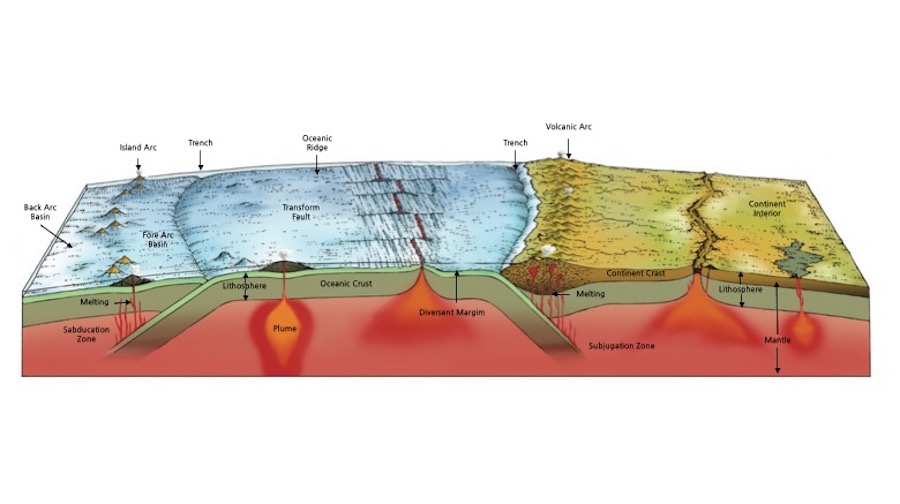Rock and Plate Tectonics
Rocks refer to either a solidified natural aggregate of one or more minerals, or a solid body of undifferentiated mineral matter or of solid organic material. In common speech, rocks mean hard stones or boulders. The earth's crust is composed of a combination of igneous, sedimentary, and metamorphic rocks.
Plate tectonics is a theory of global tectonics in which the lithosphere (crust and upper mantle) is divided into a number of plates whose pattern of horizontal movement depends on mantle convection. The plates grow along diverging plate boundaries and are consumed at colliding boundaries where a plate edge descends into the mantle and becomes molten. All the processes that form or transform the lithosphere occur in specific environments which control the species of newly forming minerals, and the chemical composition, texture and structure of the rocks. Therefore the various characteristics of rocks are closely related to plate tectonics, providing a historic record of past tectonic development of the Earth.

Plate Tectonics and Rock-forming Place
Rocks formed in different plate tectonic environments characteristically have different petrologic features.

Igneous rocks are formed by the cooling of magma generated by the partial melting of mantle and/or lower crust. At spreading centers at oceanic ridges oceanic tholeiitic basalt is generated, and around volcanic arcs and island arcs calc-alkaline magmas and resulting rocks(rhyolite, andesite, granite, diorite, gabbro, etc) are formed.
Sedimentary rocks are formed by sedimentation in various tectonic settings of the Earth's surface. On spreading oceanic ridges, calcareous mudstone, shale, chert and volcanic breccia are formed, and in fore-arc basins feldspathic and volcaniclastic wacke, mudstone and conglomerate predominate. Along transform faults, developed within continents, the deposited sediments include mafic volcanic wacke, mudstone, breccia, and conglomerate while along passive plate margins feldspathic and volcanic wacke, mudstone and conglomerate accumulate. In back-arc basins small amounts of breccia, chert and calcareous mudstone are characteristic. In addition, on oceanic plate interiors chert and calcareous mudstone accumulate very slowly, whereas in continental interiors a variety of sediments such as wacke, sandstone, mudstone, breccia, conglomerate, coal and evaporites are formed.
Metamorphic rocks are formed when a pre-existing igneous or sedimentary rock changes its character (mineral content, structure, etc.) due to changes in the temperature and pressure acting upon it. Near oceanic transform faults cataclasite and mylonite with ophiolitic features are characteristic metamorphic rocks, and at spreading centers zeolite, greenschist and amphibolite facies are formed. In the deep crust of fore-arc basins, zeolite, blueschist, greenschist, amphibolite and eclogite facies are typical metamorphic rocks, and in subduction zones beneath continental crust, greenschist, amphibolite and granulite facies are formed.